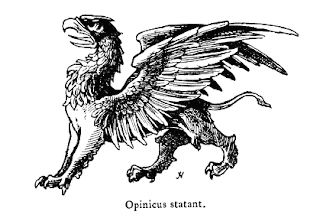
Continuing the tradition of mythical beasts, our next monster, the Griffin, comes from antiquity. The first mention of this eagle headed lion hybrid dates to at least 1500 BC on a fresco in Knossos and the creature has been with us ever since (an extensive collection of Griffin imagery from different eras is available
here). Properly described, the Griffin has the head, wings, and talons of an eagle and the large ears and rear of a lion. In some instances, the Griffin is said to also have a snake as a tail or to be as large as eight lions. It is unclear where the Griffin concept comes from, but some theories include large terrestrial birds such as ostriches or the misidentification of fossils.
In any event, the myth has been greatly expanded from a simple eagle-lion (and sometimes snake) hybrid. From the beginning of the myth, Griffins have been described as obsessed with gold and treasure, often depicted as protecting wealth. From the 9th century on, a focus shifted from appearance to describing mating habits. It was decided that Griffin's were monogamous and if one partner died before the other they would not seek a new mate. In the 12th century, the egg laying habits of the Griffin were debated, with some claiming that Griffins just had large eggs and others claiming that they hatched from chunks of agate. To add more hybridization, if a griffin mated with a horse, the result was a hippogriff. All in all, the interest in Griffin mating habits probably reflects the growing agrarian nature of society and the growing importance of husbandry.


By the 12th century, the Griffin was strongly entrenched in society. The myth was becoming more standardized, people were buying goblets made of 'Griffin' eggs (ostrich eggs) and 'Griffin' talons (antelope or sheep horns). The most enduring representation of the Griffin, however, is in heraldry. Because of the traditional association of the Griffin with nobility and wealth, it was a common charge in medieval heraldry. It was so popular, in fact, that different versions were created to keep up with demand. Removing the wings, the Griffin became an Alce. Replace the talons with lion legs and you have an Opinicus. The extensive use of Griffins in heraldry continues to today and is likely the strongest legacy of the beast, appearing on tchotchkes at any Renaissance fair or Irish festival.

In popular culture, the Griffin is all over the place but is very strongly represented in the Harry Potter series. Not only is Harry's house (Gryffindor) named after the beast, but the horse-griffin hybrid discussed above also makes an appearance. Many schools and institutions have a Griffin either in their logo or as a mascot (William and Mary or Reed College). The Griffin is also well represented in all types of fantasy writing and games. Despite it's ancient origins, most representations are associated with medieval Britain.
Next week: strap into the time machine for a truly ancient beast.

 The cockatrice legend is fairly limited in distribution. By the Enlightenment, the legend seems to have all but died out. Interestingly, the legend partially lives on in the form of the basilisk. In many early texts - and even the King James Bible - cockatrice, basilisk, and viper were used interchangeably. It's not clear how a dragon-rooster hybrid and a viper were the same, but the term cockatrice seems to have been used for any dangerous slithery creature.
The cockatrice legend is fairly limited in distribution. By the Enlightenment, the legend seems to have all but died out. Interestingly, the legend partially lives on in the form of the basilisk. In many early texts - and even the King James Bible - cockatrice, basilisk, and viper were used interchangeably. It's not clear how a dragon-rooster hybrid and a viper were the same, but the term cockatrice seems to have been used for any dangerous slithery creature.









